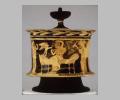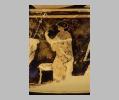| Collection: | Martin von Wagner Museum, University of Würzburg |
| Summary: | Side A: Bride sitting on a couch, with Eros, Aphrodite and woman. Side B: two Erotes wrestling, Aphrodite and women |
| Ware: | Attic Red Figure |
| Painter: | Attributed to the Washing Painter |
| Context: | From Attica |
| Date: | ca. 430 BC - ca. 420 BC |
| Dimensions: | H. (with lid) 0.136 m. |
| Primary Citation: | |
| Shape: | Pyxis with lid |
| Beazley Number: | 215006 |
| Region: | Attica |
| Period: | Classical |
Condition:
Several fragments are missing in most of the figures. The glaze is worn almost completely.
Decoration Description:
Nuptial scene. On side A, a bride in the center of the scene sitting in a kline, and an Eros coming from left flying to assist her. At left Aphrodite is standing looking at the bride. On the other side of the bride, at right, a woman is coming toward the couch bringing a loutrophoros, the vase used in the marriages for the bride's bath. The bride is dressed with a pleated belted peplos, and her hair is tied up in a wide white band dotted in black. Aphrodite is shown at the moment of putting a veil over her head.
On side B, in the middle of the scene two Erotes are fighting in the presence of three women or goddesses. The female figures hold a special variety of umpire's staff (rhabdos; not a spear). One of them, at right, is sitting in a klismos, and therefore may be identified as Aphrodite; she has also this kind of staff leaning on her shoulder. The women may also be the Moirai, according to Simon. Behind the seated woman, is standing another (perhaps identified as Peitho?). Behind her another woman is seated, playing the trigonon, a three-cornered greek harp. On the wall is hanging a wreath and on the floor, a basket sits.
The scene is a typical scene of a bride getting ready for her wedding. As she ties up her hair (or perhaps unties her hair to take a bath) she thinks of her upcoming marriage. While she is thinking of love, Eros comes to her bed to assist her. Aphrodite is there veiling (or unveiling) herself like a bride. A woman belonging to real life brings water in a loutrophoros to the bride for her bath. On the other side of the vase, Simon suggests that the two Erotes wrestling in the middle of the scene represent the struggling feelings of the bride, between love of marriage and love of maidenhood. The goddesses assisting the fighting could be the Moirai according to Simon. The seated woman could be Aphrodite and the woman behind her Peitho, goddesses related to love, seduction and destiny, all elements present in an event like a wedding. The three-cornered harp, the trigonon, occurs much less frequently on Attic vases than the lyre or the kythara, but it was apparently in favor in the late fifth and the fourth century B.C.
The Washing Painter, so called from his pictures of women washing on small hydriai and pelikai, also decorated several large nuptial vases and loutrophroi with wedding scenes
Shape Description:
The pyxis was a vessel for jewelery and was a common gift for a wedding
Sources Used:
Other Bibliography:





